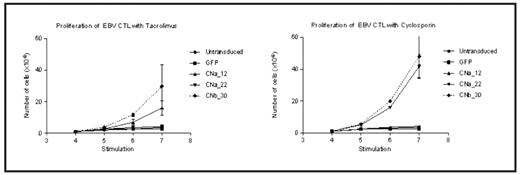Abstract
EBV-associated Post Transplant Lymphoproliferative Disease (PTLD) is a major complication of solid organ transplantation (SOT), arising from suppression of normal EBV-specific T-cell responses by immunosuppressive drugs, chiefly the calcineurin inhibitors Cyclosporin (CsA) and Tacrolimus (FK506). Previous studies in the SCT setting have established that adoptive immunotherapy with EBV-specific cytotoxic T-cells (CTL) is highly effective in preventing/treating PTLD, but results with this approach in the SOT setting have been less impressive, reflecting the ongoing need for immunosuppression to prevent rejection in SOT patients. We have addressed the critical issue of how to enable infused CTL to proliferate and function in the face of immunosuppression with calcineurin inhibitors. We report the generation of Calcineurin A (CnA) and Calcineurin B (CnB) mutants which render CTL resistant to CsA and FK506.
Based on structural data, we designed 22 CnA mutants and 32 CnB mutants predicted to dephosphorylate NFAT but not to bind to FKBP12-FK506/cyclophilin-CsA. Using transient assays with an NFAT-luciferase reporter in PMA/ionomycin stimulated 293T cells, we identified 6 CnA/4 CnB mutants which gave >15% resistance to FK506, and 5 CnA/5CnB mutants giving resistance to CsA. 4 CnB mutants resulted in resistance to both FK506 and CsA. Transduction of Jurkat T-cells with retroviral vectors coding for these Cn mutants resulted in high level expression, as determined by Western blotting/flow cytometry. The ability of these mutants to confer resistance to FK506 and CsA in Jurkat cells was then determined by measuring IL-2 secretion in response to PMA/ionomycin stimulation, in the presence of increasing concentrations of immunosuppressive drugs. Resistance was found to correlate well with that seen in 293T cells. Significantly, mutants CnA12 and B30 enabled equivalent secretion of IL-2 to untransduced Jurkats without immunosuppression despite supra-therapeutic doses of FK506 (40ng/ml) and likewise CnA22 and B30 despite supra-therapeutic CsA (800ng/ml). Some mutants rendered Jurkat T-cells more responsive to stimulation with increased output of IL-2 in the absence of IS. Next, EBV-CTLs from normal donors were retrovirally transduced with the 3 Cn mutants shown to confer greatest resistance in the Jurkat IL-2 secretion assay. In the absence of Cn inhibitors, the proportion of transduced cells, as determined by eGFP positivity, remained constant throughout subsequent culture. In contrast, in the presence of CsA/FK506, the proportion of transduced cells increased from a mean of 60% to >90% after 3 stimulations with autologous LCLs, demonstrating a selective advantage for transduced CTL. More importantly, transduced CTL were able to proliferate in response to stimulation with autologous LCL in the presence of immunosuppression, whereas non-transduced cells did not expand with FK506 or CsA. As shown in Fig 1, CTLs transduced with CnB30 proliferated at a comparable rate in the face of either FK506 (mean 30-fold expansion after 3 stimulations) or CsA (mean 47-fold expansion) to untransduced CTL not exposed to Cn inhibitors (mean 50 fold). CTL transduced with CnA22 were resistant to CsA whilst remaining sensitive to FK506. Further, transduced CTL secreted normal levels of IFN-g following stimulation with LCL in the presence of either FK506 or CsA: (CnB30 transduced CTL mean 1485 pg/ml IFN-g without immunosuppression, 1563 pg/ml in 10 ng/ml FK506 and 1600 pg/ml in 200 ng/ml CsA). In contrast, IFN-g secretion from untransduced CTL was abrogated by these drugs (mean 1538 pg/ml IFN-g without immunosuppression and 0 pg/ml with either FK506 or CsA).
In summary, we have developed a strategy that effectively renders EBV-CTLs resistant to either FK506 or CsA. Potentially this may be of significant benefit to SOT patients developing PTLD, by allowing effective immunotherapy with EBV CTL without the need for reduction of calcineurin inhibitors and the attendant risk of graft rejection. More broadly, this may represent a generic approach to enabling adoptively transferred T-cells function in the face of ongoing immunosuppression.
Proliferation of CTL in the presence of Tacrolimus or Cyclosporin A. CnB30 allows proliferation in the presence of both calcineurin inhibitors, CnA22 allows proliferation only in CsA.
Proliferation of CTL in the presence of Tacrolimus or Cyclosporin A. CnB30 allows proliferation in the presence of both calcineurin inhibitors, CnA22 allows proliferation only in CsA.
Disclosures: No relevant conflicts of interest to declare.
Author notes
Corresponding author


This feature is available to Subscribers Only
Sign In or Create an Account Close Modal